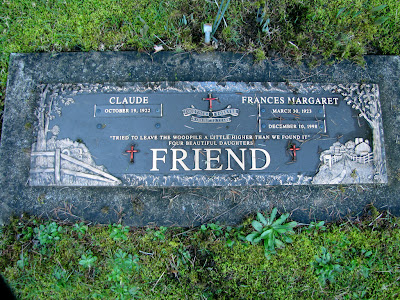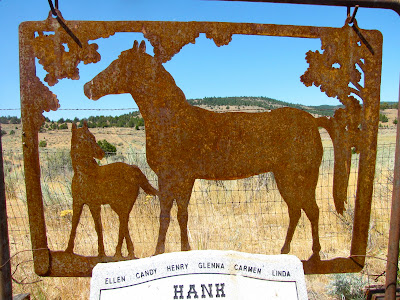 |
| Spring Grove Cemetery, Cincinnati, OH (Photo: Davis Paul Ohm) |
I should recuse myself right from the beginning. I’m not a neutral observer. I’ve got a lot of reservations about lawn cemeteries and John Llewellyn, author of
A Cemetery Should Be Forever: The Challenge to Managers and Directors (Glendale, CA 1998), manages the cemetery that started that trend: Forest Lawn in California. I’ll extend a further disclaimer that I’ve never been to Southern California and have never set foot inside Forest Lawn. Who knows, I might love the place.
I was handed a copy of this book by Rachel Fox, manager of fourteen pioneer cemeteries for Metro, the local multi-agency operation that handles much civic responsibility here. I was inquiring as to the beginnings of commercial cemeteries: which was first? She thought Llewellyn might have an answer.
But first another story:
A few years back I happened to have a meeting with the manager of River View Cemetery, Portland’s premier “garden” or “rural” cemetery. While modest compared with other cities, our rural cemetery suits us fine. As I was leaving the meeting, I asked the director about the history of River View. I asked specifically about its design: who did it and how did it come about? The director opined that he thought there hadn’t been much planning at all, that they’d simply laid the roads out following the natural contours of the hill. Then he gave me a brochure detailing the history of the cemetery. Sure enough, the brochure commented on the many months of careful planning with landscapers and designers that were spent before any earth was moved. The director had neglected to read his own brochure.
Likewise, despite being seeped in the industry for three generations (his great uncle was Hubert Eaton, the messiah of Forest Lawn), Llewellyn apparently forgot to study his history. As far as Llewellyn is concerned, “the Burial Act of 1855 marked the beginning of cemetery development in Great Britain, although several cemeteries had been established earlier in London by private enterprise”; leaving one with the impression that this is what started it all in America, as well. Even the very invention of cemeteries didn’t impress Llewellyn. In his view, “when Hubert Eaton conceived his ‘memorial-park plan’ in 1917, he transformed the way cemeteries were operated and viewed by society. Up to that point, changes in cemeteries had been slow—evolutionary.” Llewellyn dismisses The roles of Père Lachaise and Mt. Auburn as being “influenced by [the] design” of rural cemeteries. He never mentions Albert Strauch and the creation of the cemetery superintendent position at Spring Grove Cemetery in Cincinnati, even though a president of Spring Grove Cemetery and Arboretum wrote the foreword.
 |
| Spring Grove Cemetery, Cincinnati, OH (Photo: David Paul Ohm) |
The reality is that Mt. Auburn in Cambridge, MA, a scion of Père Lachaise in Paris, was, in 1831, the first “rural” cemetery in America. Those cemeteries began the rural cemetery movement and could not have been influenced by it. Spring Grove and Albert Strauch made the first restructuring of the rural cemetery with the creation of the superintendent’s position, which he accompanied with design innovations presaging Eaton’s lawn cemetery. The real transformation of American cemeteries was ushered in with the invention of the commercial cemetery, which Llewellyn guesses to be around 1860, a date which seems reasonable. Still, it would be nice to know which cemetery that was, for that was a truly transformative move. That’s when death entered the market place.
A point Llewellyn doesn’t like to dwell on. He could have entitled his book, A Cemetery Is Forever. Instead he chose Should Be. Yeah, they should be; but are they, if they’re a commercial enterprise?
Llewellyn follows David Charles Sloan’s
The Last Great Necessity: Cemeteries in American History in his classifications of American cemeteries: frontier, domestic, churchyard, potters’ field, municipal, lawn-park, and memorial park. “Frontier” in his definition means roadside grave left by pioneers on their way west. Technically, that’s a “grave site” and not a cemetery. “Lawn-park” and “memorial park” don’t appear significantly different and should probably be lumped together. Potters’ fields are historical appendages and don’t exist anymore outside institutional graveyards, such as asylums or prisons. By “domestic” he means family graveyards; they exist but are not an option for most people. That leaves us with churchyards, municipals, and memorial parks.
 |
| Mt. Auburn Cemetery, Cambridge, MA (Photo: friendsofmountauburn) |
I’m not sure that’s a helpful enough distinction. I’d argue that the most significant line should be drawn between civic and commercial cemeteries, with churchyards put in a category of their own. I would define “civic” as those cemeteries supported by a tax base, and “commercial” as those supported by corporations. A civic cemetery might generate enough income to not require tax support, but the ultimate responsibility for the maintenance of a civic cemetery is a governing body, be it city, county, state, federal, or otherwise. The responsibility for a commercial cemetery, whether for-profit or not, rests with the owner or, most often, owners.
Within those broad divisions, of course, there are many variations. Llewellyn manages to write an entire book about cemeteries and never mentions the Masons or the Odd Fellows; yet their cemeteries occupy a gray area straddling the line between civic and non-profit commercial. In spirit they’re closer to churchyards, as fraternal organizations are closer to churches than to governments or corporations. Perhaps we can lump church and fraternal cemeteries together as “community” cemeteries.
Any cemetery is open to abandonment, but we can rank the three cemetery types—civic, commercial, and community—by their likelihood of abandonment. With absolutely no statistics to back me up, I’d guess that it’s a toss-up between commercial and community, but that civic cemeteries, by the nature of the duration of governments, have the best chance at long term survival. Llewellyn only skirts the issue of whether or not corporations should be involved in the death business at all, whether it’s a proper subject to leave to the whims of the market place? He neglects to compare the life cycles of corporations versus the life cycle of governments. He never asks what happens when you give your eternity over to Pan Am or Bell Telephone? He never confronts the problem of when your cemetery starts to look like Detroit.
No indeed, most of his book is devoted to questions of cemetery management, which is its proper subject: how to make wise investments, make plans for the future, etc. His concern is how to keep the cemetery going, not what to do after it fails. He often talks about pricing, largely as an apologist for the industry, shaking his finger at the independent monument and casket sellers, not to mention at the cremation business. (He tells a story of someone being dusted with cremation ashes once, but never talks about stacks of bodies like cordwood outside mortuaries; and I assure you he would never mention necrophilia.) He stresses that one has to give quality service at a fair price in order to remain in business over the long haul, although he does admit that occasional price gouging does exist. He offers an interesting defense: “Although mortuaries’ prices have been criticized as being too high, consumers have not encouraged price competition.”
Ah ha! We knew it! Consumers are responsible for setting prices, not the seller. If only we’d grump more, prices would be lower. If we don’t grump, they’ll rise until we do. Why, that’s only fair, no? That’s what capitalism is all about: squeezing the last dollar out of you, even if you’re dead. So, if you want a better price on your funeral, write your funeral home now and tell them so. That ought to do the trick.
 |
| Mt. Auburn Cemetery, Cambridge, MA (Photo: friendsofmountauburn) |
There is a suggestion that Hubert should have been named Hubris. If there was one thing Eaton had faith in, besides his god, it was himself. The comment has been made, “someone along the line convinced him he had taste.” In a display of sweeping arrogance, Eaton proclaimed his “Builder’s Creed,” where he laid out his vision of a cemetery, one to which you’d better conform if you want to be buried in Forest Lawn: “I therefore know the cemeteries of today are wrong because they depict an end, not a beginning. They have consequently become unsightly stoneyards, full of inartistic symbols and depressing customs….” In one fell swoop he condemned everything that went before him. Your style of mourning depresses him or offend him. Individual expression, personal displays of remembrance are inadequate. We need the sage from Liberty to bring us the proper respect for the dead in a uni-grave system “where memorialization of loved ones in sculptured marble and pictorial glass shall be encouraged but controlled by acknowledged artists….” One can only presume that it was an acknowledged artist who suggested bringing in fake copies of famous Italian statuary. And surely it was an acknowledged artist who suggested putting a fig leaf on David. The last thing we need is a prick hanging out in the cemetery.
What Eaton was—and is—selling was a Christian view of life and death. As much as possible, he wanted to drive death from the cemetery. Starting with the name. No more cemeteries; from now on they shall be memorial parks. We don’t honor the fallen here, only the resurrection. “I believe, most of all, in a Christ that smiles and loves you and me.” Feel safe now?
An initial impulse that drove the creators of Père Lachaise was that their new cemetery should be an attractant for the populace. It was hoped people would come and stroll the grounds and be edified and uplifted by the sculpture and mausoleums doting the landscape. This theme was carried over to the rural cemeteries of America. Eaton did nothing new in attracting people to his cemetery; he simply broadened the base of offerings and made the whole design his design, rather than yours. In a way he was the Walt Disney of cemeterians. It’s no coincidence that both Disney World and Forest Lawn were born in Southern California; they share a similar gestalt.
 |
| Hollywood Forever Cemetery (Photo: Jennifer Gaillard) |
A Cemetery Should Be Forever was published in 1998, the same year Tyler Cassity bought the moribund Hollywood Memorial Park. Llewellyn’s book was
au courant in noting the newcomer. He was discussing endowment issues when he mentions Cassity. He warned “the buyer is taking on a huge challenge, and it isn’t clear how enough funds will be found to bring the cemetery up to even a minimal level of maintenance.” Cassity went on to steal Llewellyn’s title and rename his cemetery, Hollywood Forever. Welcome to the new Eaton. And from Missouri, nonetheless. He gets all the new star burials. He found the funds.
But will Hollywood Forever last forever? Probably no more so than Forest Lawn. You can put any shade of lipstick on them you’d like, but they’re still commercial cemeteries. One of these days they’ll disappear, go bankrupt, kaput. Welcome to Detroit.
 |
| Hollywood Forever (Photo: Jeremy Weatherly) |














